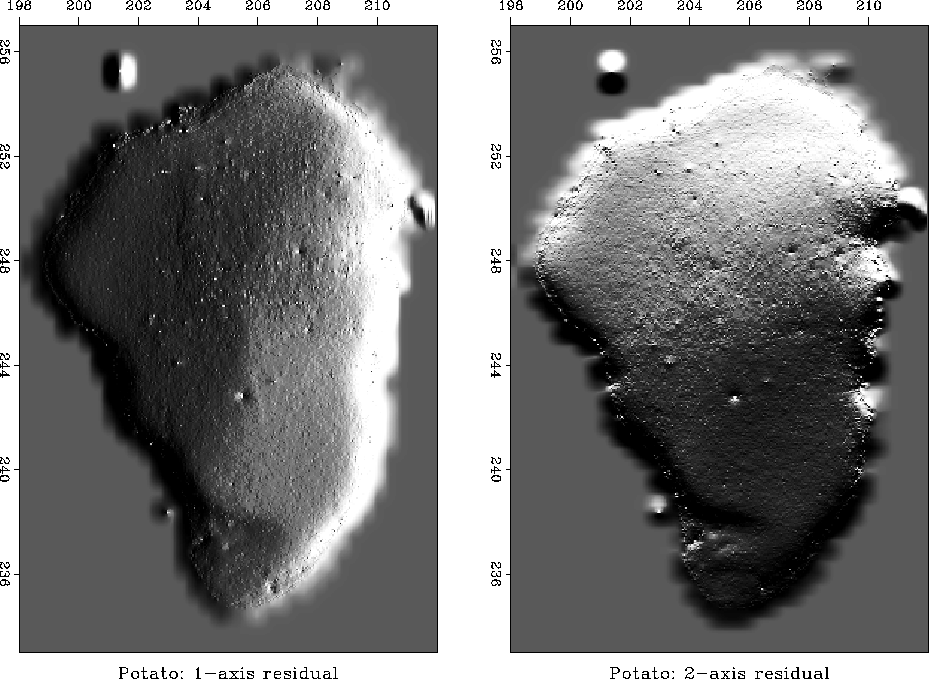subroutine potato( xy, dd,nd, o1,d1,o2,d2, mm,m1,m2, niter)
integer iter, i, nd, m1,m2, niter
real xy(nd,2), dd(nd),o1,d1,o2,d2, mm(m1,m2), rbar, aa(100)
integer nr, rd,rm, na
temporary real rr( nd + 2*m1*m2), ad(nd), wr(nd), ww(nd)
temporary real dm(m1*m2), dr( nd + 2*m1*m2)
temporary real sm(m1*m2), sr( nd + 2*m1*m2)
nr= nd + 2*m1*m2; rd=1; rm=1+nd
na=4; aa(1)=1.; aa(2)= -.44; aa(3)= -.46; aa(4)=-.05
call scaleit( 2., na, aa)
do iter= 0, niter {
call negcopy( nd, dd, ad ) # -d
call dpbin2( 0, 1, o1,d1,o2,d2,xy,mm,m1,m2, ad ,nd) # r_d= -d+Bm
rbar=.5; rbar=2.5; rbar=1.0
do i=1,nd
ww(i) = 1./sqrt( 1. + (ad(i)/rbar)**2 )
call icai1( 0, 0, 1, aa,na, ad ,nd, rr(rd) ) # r_d= A(-d+Bm)
call diag( 0, 0, ww, nd, rr(rd), rr(rd) ) # r_d=WA(-d+Bm)
call igrad2( 0, 0, m1,m2, mm, rr(rm) ) # r_m = G m
call diag( 1, 0, ww, nd, wr, rr(rd) ) # Wr_d
call icai1( 1, 0, 1, aa,na, ad ,nd, wr ) # dm = A'Wr_d
call dpbin2( 1, 0, o1,d1,o2,d2,xy,dm,m1,m2, ad ,nd) # dm = B'A'r_d
call igrad2( 1, 1, m1,m2, dm, rr(rm) ) # dm= dm + G'r_m
call dpbin2( 0, 0, o1,d1,o2,d2,xy,dm,m1,m2, ad ,nd) # dr_d = B dm
call icai1( 0, 0, 1, aa,na, ad,nd, wr ) # dr_d = AB dm
call diag( 0, 0, ww, nd, wr, dr(rd) ) # dr_d =WAB dm
call igrad2( 0, 0, m1,m2, dm, dr(rm) ) # dr_m = G dm
call cgplus( iter, m1*m2, mm, dm, sm, _
nr, rr, dr, sr )
}
return; end
It is pleasing to see the ship's tracks gone at last.
![[*]](http://sepwww.stanford.edu/latex2html/cross_ref_motif.gif) .
Including such a weighting function gives us the map-fitting goals,
.
Including such a weighting function gives us the map-fitting goals,
![[*]](http://sepwww.stanford.edu/latex2html/cross_ref_motif.gif) ) or
(
) or
(![[*]](http://sepwww.stanford.edu/latex2html/cross_ref_motif.gif) ).
The first time I solved the problem,
I chose the PEF
).
The first time I solved the problem,
I chose the PEF ![[*]](http://sepwww.stanford.edu/latex2html/cross_ref_motif.gif) .
I tried various scalings between the first and second parts of (7)
and various values of the average residual
.
I tried various scalings between the first and second parts of (7)
and various values of the average residual ![[*]](http://sepwww.stanford.edu/latex2html/cross_ref_motif.gif) ) and
(
) and
(![[*]](http://sepwww.stanford.edu/latex2html/cross_ref_motif.gif) ).
Some sample noise PEFs I found were
).
Some sample noise PEFs I found were
